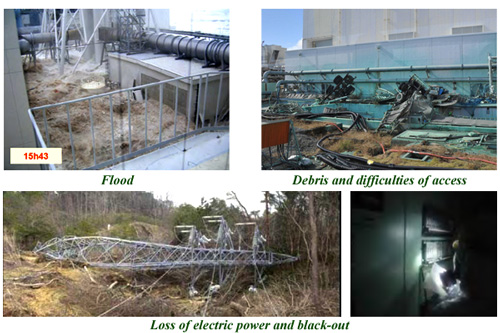Erecting barriers between environment and radioactivity
The safety of nuclear reactors has always been carefully monitored by strict regulations enforced by public organisations such as the Nuclear Regulatory Commission (NRC) in the United States.

Three barriers to confine radioactivity
Sketch of the three confinement barriers which confine radioactivity inside PWR reactors : the cladding containing the radioactive fuel rods , the primary circuit and the outermost boundary formed by the walls of the reactor building . These three barriers act with complete independence from each other, ensuring a greater level of security.
© EDF/electra
Over the years, these safeguards have resulted in an extensive safety culture, all the more remarkable for the over 400 reactors worldwide which have been working problem-free for more than 30 years. The clean record enjoyed by nuclear energy was severely tarnished by the Chernobyl accident. This led a sector of public opinion to see living next to a reactor as unacceptably dangerous. Is that really the case?
The RBMK reactors involved in the Chernobyl accident were known to have flaws in terms of operational safety. But the accident occurs mainly because plant operators had violated established security protocols. The accident has led to strengthen the safety rules and to develop what is commonly called a culture of safety for all types of reactors. Measures have been taken to help countries of the former Soviet Union and Eastern Europe to improve the condition and the design of their plants (*).
This performance has been questioned after the Fukushima accident caused by the tsunami that devastated the Japanese coast on March 11, 2011. The accident occurred after the shut down of the reactors. It was due to the failure of the cooling systems that were drowned. Following the accident, a review of the reactors was ordered in many countries. Even in countries like France where the tsunami risk is infinitesimal compared, it was to draw lessons from the accident and to correct the failures, notably to ensure an adequate cooling after shut down.

Plan for the unforeseeable
The Fukushima accident has shown that it is also necessary to guard against external nobn nuclear events. The earthquake of magnitude 9 caused the loss of high voltage lines feeding the plant. Then the tsunami drowned the emergency diesel generators, causing a blackout that stop the cooling pumps. Finally, the tsunami and explosions scattered around multiple debris impeding rescue actions. The coincidence of all these failures were not foresseen. For instance, to avoid the accident, it would have been enough to have higher dikes or to shelter diesel groups from water .
© DR
Safety principles : Stable operating point and defence in depth
Nuclear engineers keep the ratio between quantities of nuclear fuel and moderator such that the reactor can naturally regulate itself under the laws of Physics. A stable point of operation is carefully chosen so that for any change in the equilibrium conditions, the reactor will react in such a way as to counter the change. If the reactor counteracts to lower or increase the criticality as needed, it is said to have a ‘negative criticality coefficient’. One of the flaw of the Chernobyl RBMK was to have a positive coefficient and therefore instability at low power.
The safety is complemented by the monitoring of the chain reaction. Safeguard devices such as control rods and emergency rods allow to shut down the reactor rapidly should anything go wrong
In the advent of a serious accident, the interposition of multiple barriers between the environment and the radioactive fuel ensures environmental protection. This is the principle of defense in depth. It was these multiple barriers of defence that proved crucial in preventing the 1979 ‘Three Mile Island’ accident from getting out of hand. If the Chernobyl reactor had possessed the same defence mechanisms, the radioactive material would not have dispersed into the atmosphere.
The probability is very low that an accident on such a scale could repeat itself with the reactors currently operating in the Western World. New models, such as the French-german Generation III European Pressurized Reactor (EPR) have exhaustive security measures which minimise the risks of radioactive leakage. PWRs are also designed to counteract the consequences of fusion taking place in the reactor core – an accident which is itself highly unlikely.
Articles on the subject « Reactor Safety »
Confining Radioactivity
Three barriers … One major challenges of nuclear installations safety is to master the conf[...]
Reactors Cooling
Evacuate the heat of fissions and radioactive decays To ensure the safety of a reactor requires t[...]
Reactor Shutdown
The embers of fission … When shutting down the reactor, whether for reloading the fuel or a[...]
Reactor maintenance
Provide the best safety for reactors during decades Nuclear reactors are designed to operate for [...]